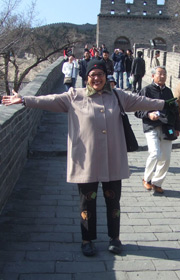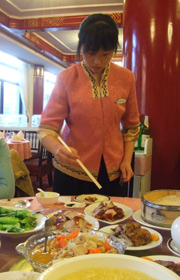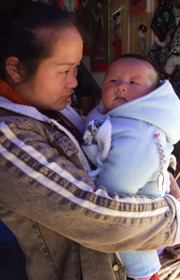Little Cooks on The Great Wall
Part two of a series on the media visit to China

During my recent stay in Beijing, China, I was lucky enough to get to see some of their major tourist sites. I was most impressed by the Great Wall of China and awed by the greatness of it. It is hard to imagine how they ever built it and it is a truly amazing sight to behold.
One of the greatest wonders of the world, The Great Wall was enlisted in the World Heritage site list by UNESCO in 1987. Just like a gigantic dragon, the Wall winds up and down across deserts, grasslands, mountains and plateaus, stretching approximately 6,700 kilometres from east to west of China. With a history of more than 2000 years it is one of the most appealing attractions all around the world owing to its architectural grandeur and historical significance.
The best preserved and most imposing section of the wall is at Badalin in Beijing. The section is made of large blue rocks and has an average height of 7.8 metres. Walking the wall isn’t easy. Not only does it rise quite steeply, but along with the hundreds and hundreds of steps you also have to navigate your way through the crowd.
I was told that there are always large numbers of tourists visiting and walking the wall and that the crowds are worse during their holiday season. I noticed inscriptions on the wall and was told that it was people’s names; previously visitors to the wall would inscribe their names on it, a memento of their visit.
However, that is not the case today and it is forbidden to desecrate the wall in any way. Along the wall there are guards posted at regular intervals. Their role is to keep the crowd moving and under control. Depending how fit you are and how much time you have there is a long section open for the general public to walk. There are also stalls along the way where you can purchase souvenirs.
The people

The first thing that struck me was how beautiful the women are: tiny delicate beautiful dolls and slim. Us Pacific women, felt like clumsy giants around them. I didn’t see any overweight people, none at all.
While some had round faces their bodies weren’t. I always thought all Chinese people were short but no, I was astonished to see several tall men and women. Mind you with a population of 1.4 billion what are the odds of being tall?
.The women are fashion conscious and up to date with the latest trends and are always neat and tidily dressed; you don’t see anyone looking scruffy. The women I saw in Beijing city all favoured tight jeans/trousers with high heeled boots or shoes. I was amazed to see one woman cycling wearing stilettos.
Their young people are like teenagers anywhere. They also like to keep up with western trends and sport the latest funky hairstyles, clothes and accessories. To be fair the majority of my time was spent in the city, people in the rural areas may be different.
I also kept getting glimpses of people that I thought I knew, a lot of the Chinese I saw have facial features similar to Cook Islanders. We did attract attention whenever we went out as it is uncommon to see foreigners wandering the streets by themselves, foreigners mostly visit in large tour groups.
We were stared at a lot and people were interested to find out where we were from. I found that no one had ever heard of the Cook Islands or New Zealand. Several people had heard of Australia. The easiest thing for us to say was that we were from the South Pacific. I found the people in Beijing to be friendly and the only problem that I had was being able to communicate adequately with them.
Roast Beijing duck

Tasting a variety of local food was a real treat for us and we were taken to a special restaurant for a meal of Roast Beijing Duck. Said to enjoy a reputation of the most delicious food in Beijing, it is a dish that is well known throughout the world.
China is one of the first countries to domesticate ducks for the table and they are used in a variety of ways. Cooking methods include steaming, boiling, stewing, and roasting.
Once only served to the Imperial family and the upper class of society, the dish is considered a specialty of Beijing City and several restaurants serve it. The ducks are hung from a hook in the ceiling of the oven and roasted over burning wood, a bit like a pig on the spit.
Another method is to first heat the walls of the oven whereupon the duck is cooked by the heat given off the walls. A duck roasted in this manner is crisp to touch and golden brown in appearance, its flesh is both tender and tasty. The duck is also carved in such a way that everyone receives a slice of duck with skin.
In the restaurant, the roast duck is first shown whole to the customers. Slices are eaten rolled in thin pancakes with a dish of sweet sauce for dipping. Inside the pancake along with the slices of duck you add spring onions or thinly sliced cucumber.
Few people if any could resist the temptation of the crisp and delicious taste of Roast Beijing Duck. Just ask Bobby, who professes to be a vegetarian and who was seen to enjoy several pancakes of Beijing Duck.
One child

The one child policy is something that everyone knows about China. Concerned about their rising population, currently 1.4 billion, this policy was seen to be a way of keeping the climbing birth rate under control. The idea is for families to consist of a mother, father and one child.
Attractive packages are given to those who adhere to this policy and denied to those who don’t. According to one Professor it is mainly those who live in the rural areas who have more than one child, the reasons for this are for labour and if the first child is a girl they will try again for a boy. As in India, males are highly regarded in Chinese families.
However, they now have a problem with having a population of more men than women.
Asked about unwed mothers and single women who had children outside of marriage the same professor said that there was no such thing in China as unwed mothers.
Pressed further he did admit that abortions, terminations, were readily available to women in China. However, there are still no unwed mothers in China, it is against their culture. He was most adamant about that.
In the case of a divorce or death of a partner the Professor told us that if a couple is marrying for the second time around they may have a child only if the woman has not had any children. This doesn’t apply to the man if he had a child in his first marriage as long as his future wife has not had a child. It seems this policy is only targeted at women.
Because of the problems they are experiencing with the one child policy and the social complications that have arisen from this they have decided to bend the rules a bit. If a couple both come from a one child family they may have two children. Sorry that should be they may have two pregnancies, as multiple births are exempt. This two-child policy does not apply to people who have siblings.
Speaking to several people, the majority said they are quite happy to have one child or to be an only child. Some women did admit to a yearning for more children. A lot of people can only afford to have one child, especially those who live in the city.
Only children I spoke to said they don’t get spoilt or given special privileges from their parents. Only children said it’s the only thing they know so they don’t know any different.

Headlines : Times 196 16 April 2007
- PM: Why I now
back Media Bill
- Media Standards Bill select committee
- The loo with a view
- Boxing: Now there’s 4 for Oceania
- New shade house ready next week
- Media Bill steamrolling concerns
- Arorangi sChool Tsunami Drill
- Little Cooks on The Great Wall
- Report spotlights Sir Fred’s escorts
- How Chinese Taipei tested our U19 team
- Big boost for sailors